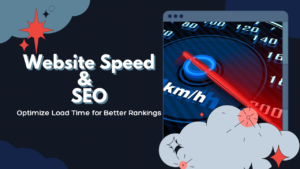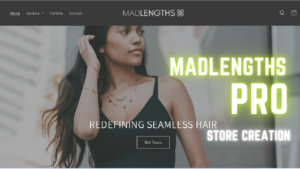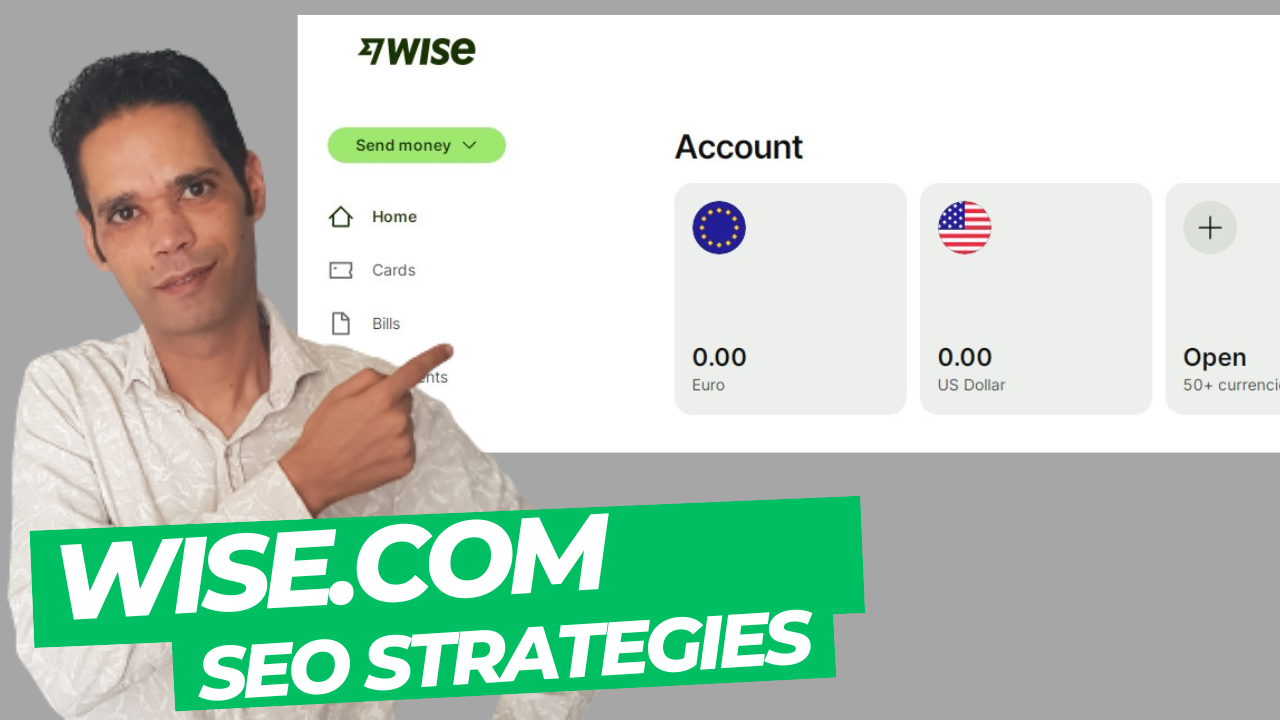
Formerly known as TransferWise, this fintech (financial technology) company that offers multi-currency accounts and fast international transfers with attractive fees, has an estimated organic traffic of 6.4 million monthly visits:

This is particularly impressive because they switched domains in early 2021. A migration so successful that the entire SEO community was talking about it. Add to that that they have a proprietary CMS to accommodate their SEO efforts, and you have a brand whose SEO strategy deserves analysis.
In this very specific case study, we’ll explore five reasons why Wise’s SEO strategy rocks:
- A repeatable landing page template
- A custom CMS built around their SEO needs
- Content optimized for featured snippets
- Multiple ways to attract and acquire backlinks
- Migrating millions of pages without errors is very risky
1- A landing page template that can be repeated
Doing keyword research is usually the easiest part of creating a content strategy, so it’s no surprise that the content Wise produces accurately reflects what their (potential) customers are looking for.
The challenge becomes serious when your keyword research tells you that you should publish tens of thousands of landing pages. How to create and optimize so much content to be well positioned in Google?
Wise tries to be present in search results throughout the customer journey and there is a lot of content to cover. Especially at the entrance to the funnel.
For example, they have almost 12,000 landing pages about Swift code combinations that only target the US market:
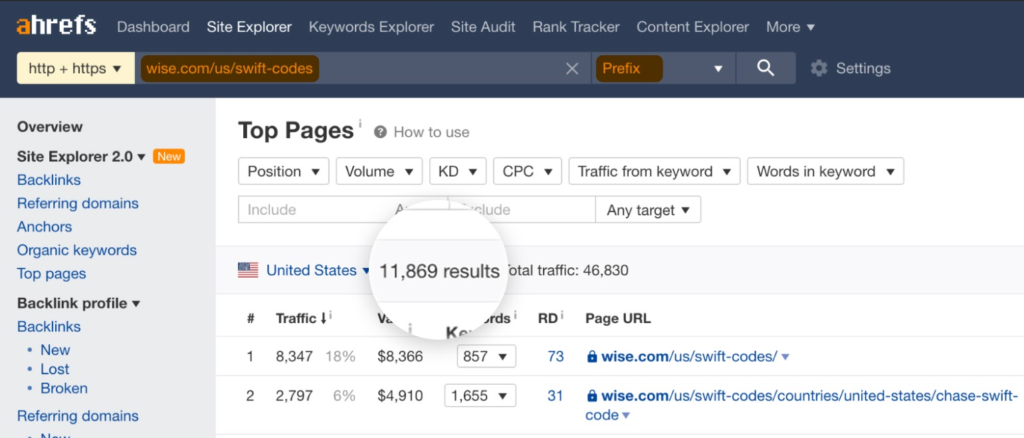
And it’s not just the swift codes sub-folder that has so many landing pages. There are other subfolders with thousands of pages on topics like currency conversions or routing numbers:
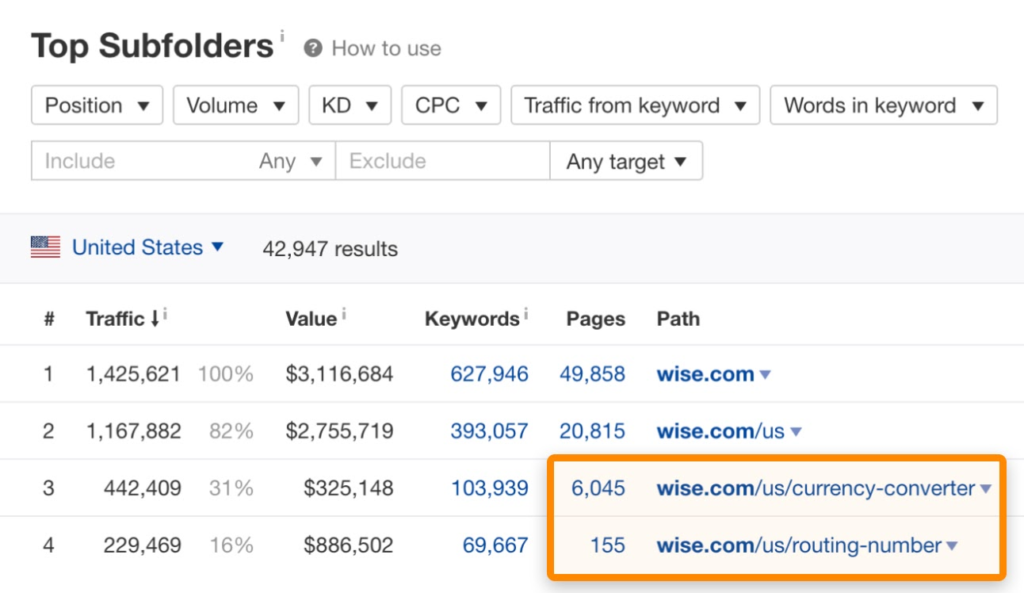
These more top-of-funnel (beginning of the customer journey) focused pages contribute the majority of their organic traffic across multiple countries and languages. Here is an example of their German traffic:
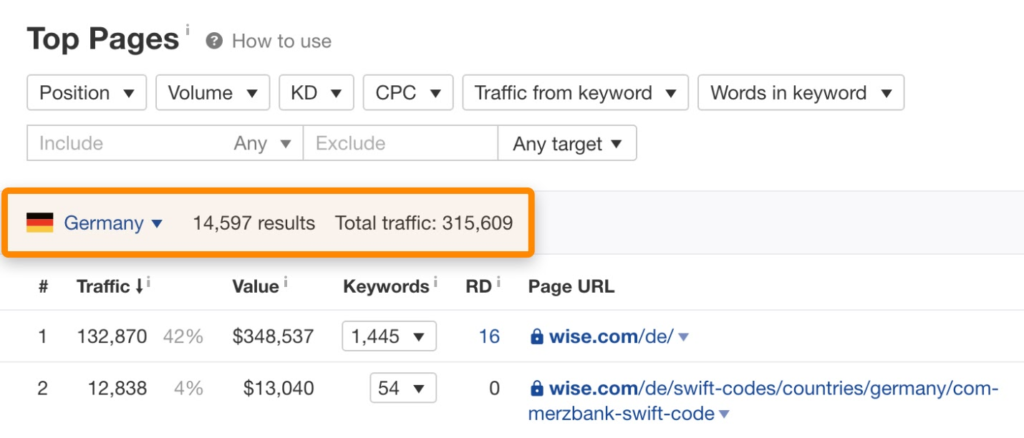
The trick to creating so many optimized landing pages is to use templates, which is what Wise did. They realized that people looking for specific SWIFT/BIC codes or routing numbers want very similar information. The only variable is the code itself.
From a content perspective, all they needed was a perfectly designed landing page for a specific bank. From there, they re-apply the model again and again for different banks.
Creating such well-designed pages requires excellent writing, design, UX and aligning with the search intent: giving all the information the user needs. An example of what users are looking for can be found in their FAQ section (which by the way maximizes SEO opportunities via the FAQ rich snippet):
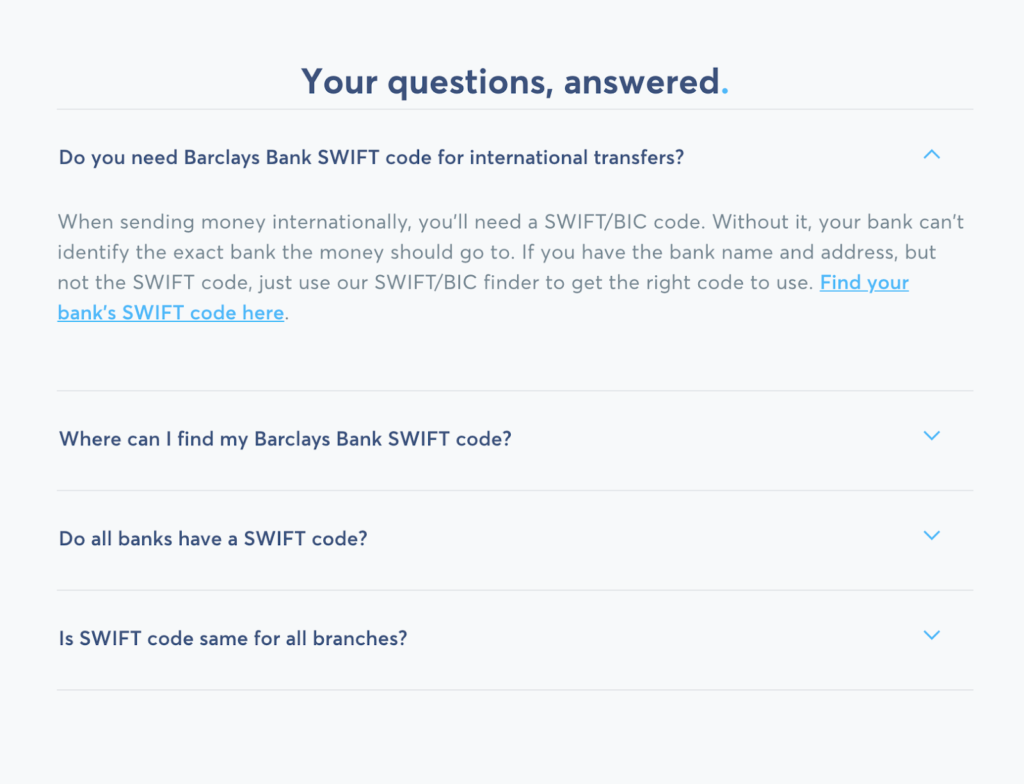
In the end, Wise succeeded in scaling up their content creation with a focus on SEO. Their organic traffic climbs with the number of indexed pages:
2- A custom CMS built around their SEO needs
Scaling content creation to the point of what Wise needed requires resources and developers. You can’t produce so much content in different languages with current standard CMS options.
In the presentation of Fabrizio Ballarini, the person in charge of organic growth of WIse, he indicates some crucial points of the SEO features of their custom CMS, Lienzo:
- Use templates and boilerplates to create thousands of new landing pages quickly
- Properly manage internal links
- Generate and update meta tags and structured data at scale
- Manage hreflang attributes and canonical tag generation and updates
- Clone, update or delete pages at scale
- Test changes in a local environment before sending them to production
- Integrated ASAP issue tracking, detection and remediation platform
- Built-in split testing tools for SEO experiments
- Seamless integration with database APIs
- Assign user roles so team members have access to the tools they need
That might seem like a lot to take in, so here’s an example of its UI:

While it may seem risky to push so much content from a technical perspective, Wise has managed to attract more and more attention from Googlebot over time:
The more content you feed the Google bot, the more it will become addicted to crawling, indexing and raising your site. Especially for brand new sites, it is important to continue to provide good quality pages. My favorite KPI at the start of a project is the number of indexed pages/month.
Getting Google on their side must have been a challenge. Already, each page had to be unique, have value and align with search intent. They then had to update the internet links and sitemaps to ensure good crawling and fast indexing.
Lienzo seems to do all of this much better than any standard CMS.
3- Optimized content for featured snippets
One of the things that fascinated me about Wise’s SEO performance is the number of featured snippets they have. I didn’t know if they were just doing a better job than the competition or if it had to do with the nature of SERPs in the financial industry.
So I looked at the competing domains:
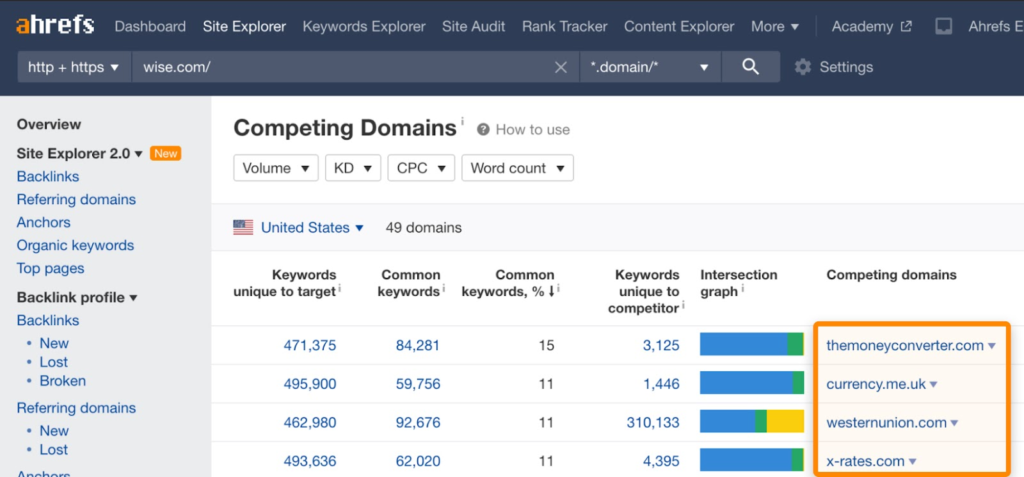
Ahrefs Site Explorer’s Competing Domains Report shows sites that rank in the top 10 for the same keywords as the site you’re looking at.
I then chose a few of them with good organic traffic and lots of overlapping keywords. I wanted to know how many keywords that “trigger a featured snippet” rank in the top 10 and how many they won.
Here’s how I went about using the Ahrefs Site Explorer for each of the sites I was investigating:
- I entered the domain
- I’ve been in Organic Keyword Report 2.0
- I filtered keywords in position 1–10
- I filtered the keywords that trigger a featured snippet, write the number of results
- I filtered the keywords triggering rich snippets that the domain has and noted the number of results (this is the step you see below)
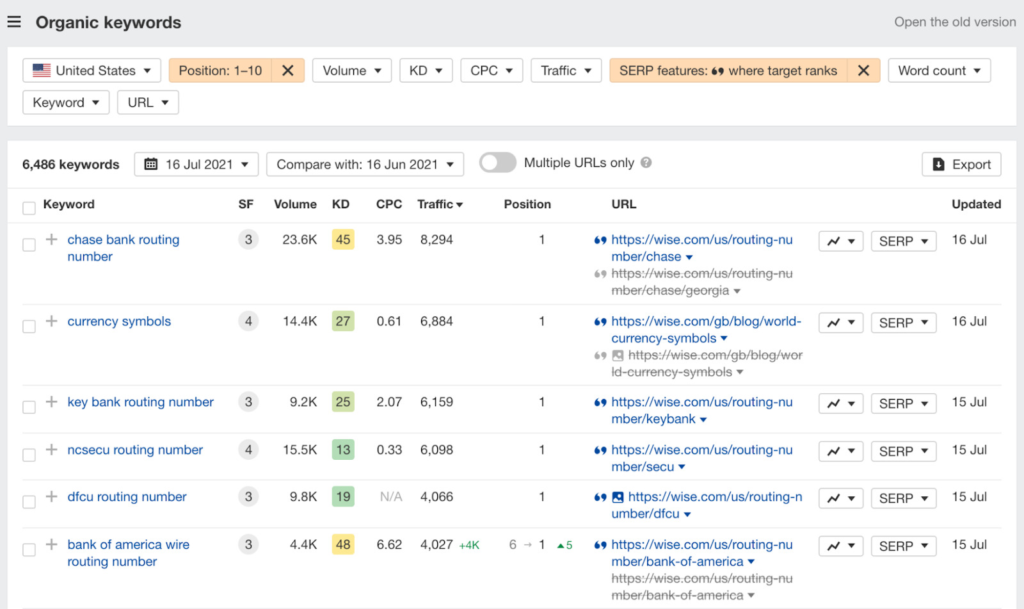
It’s clear that Wise does a really good job of optimizing featured snippets and it gets a lot of traffic to them. I’m quite surprised that their competitors don’t do a better job with so many easy-to-grab opportunities, like this one:
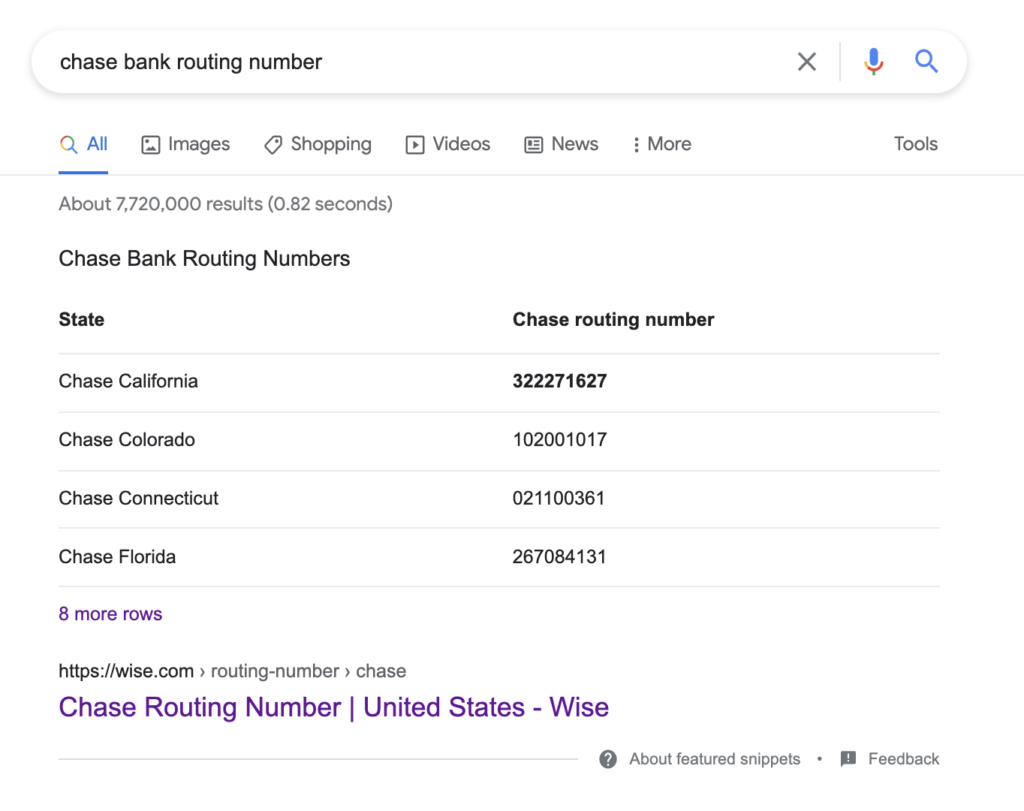
You have to ask yourself: how do you make one painting better than another? It must be a kind of Google lottery to know which one to choose to highlight it, right? Well here is what the table looks like on the Chase website.
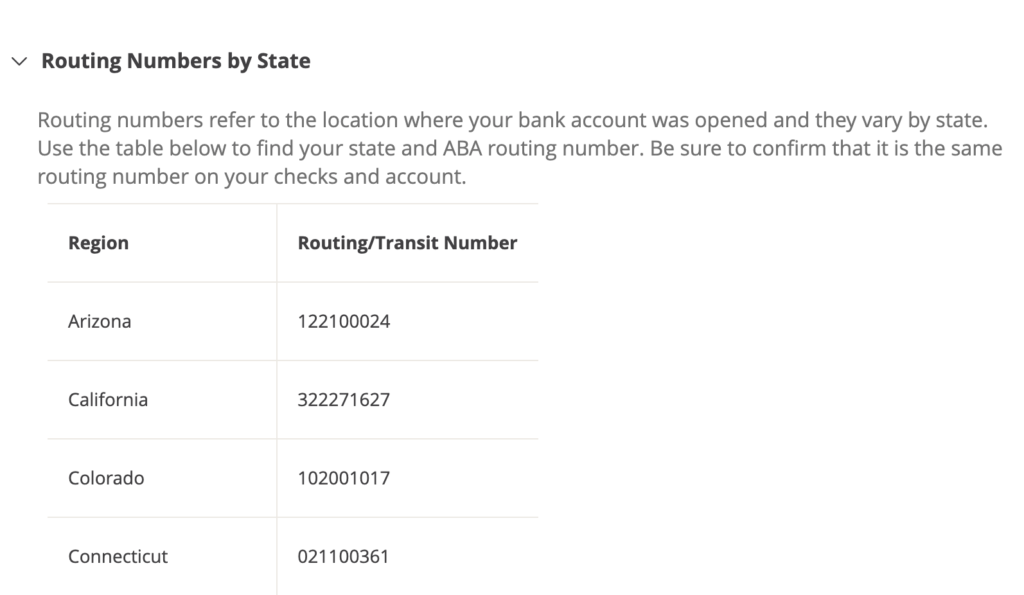
They put it in an accordion block which is unfolded by default. This is not the main content of the page. The column names could be better, and it wouldn’t hurt to mention somewhere in the context of the table that they are indeed Chase routing numbers.
Wise does it all better, they annotate the table with a clear title and link each row to the relevant landing page.
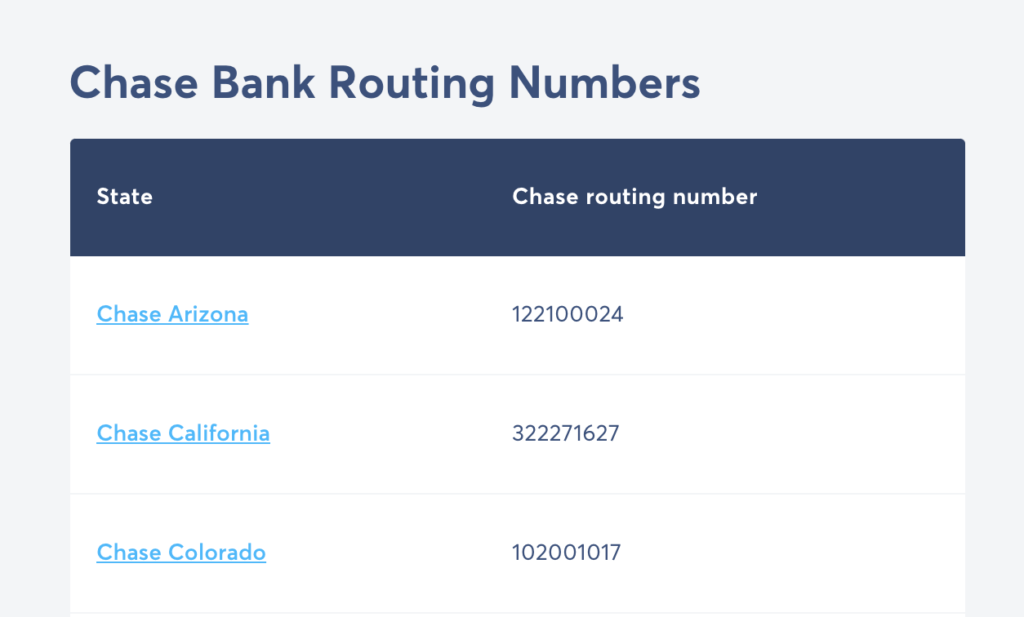
I’m not saying that such optimization will ensure you get a featured extract, but Wise is more deserving on this one.
5- Multiple ways to attract and acquire backlinks
Even the best practices, settings, process and application of on-page and technical SEO are not guaranteed to appear in the SERP if your content lacks strong backlinks. Link building is the least controlled part of SEO, so it’s always a good idea to use multiple link building tactics and approaches. Wise also does a great job on the subject.
Product-Based Businesses Naturally Attract Links
Your best link building weapon is something over which you don’t have much influence as an SEO professional: a genuinely popular and useful product. This often comes with a strong brand. I’m a happy Wise customer myself and was already familiar with them long before I converted.
Having the best product in its sector allows you to naturally build a good profile of backlinks without actively seeking to have them with outreach. Besides, Wise did not have an SEO team before 2015, they managed to have very good backlinks with a little public relations and advertising.
Getting a Domain Rating (DR) of 75 without an SEO team is very impressive:
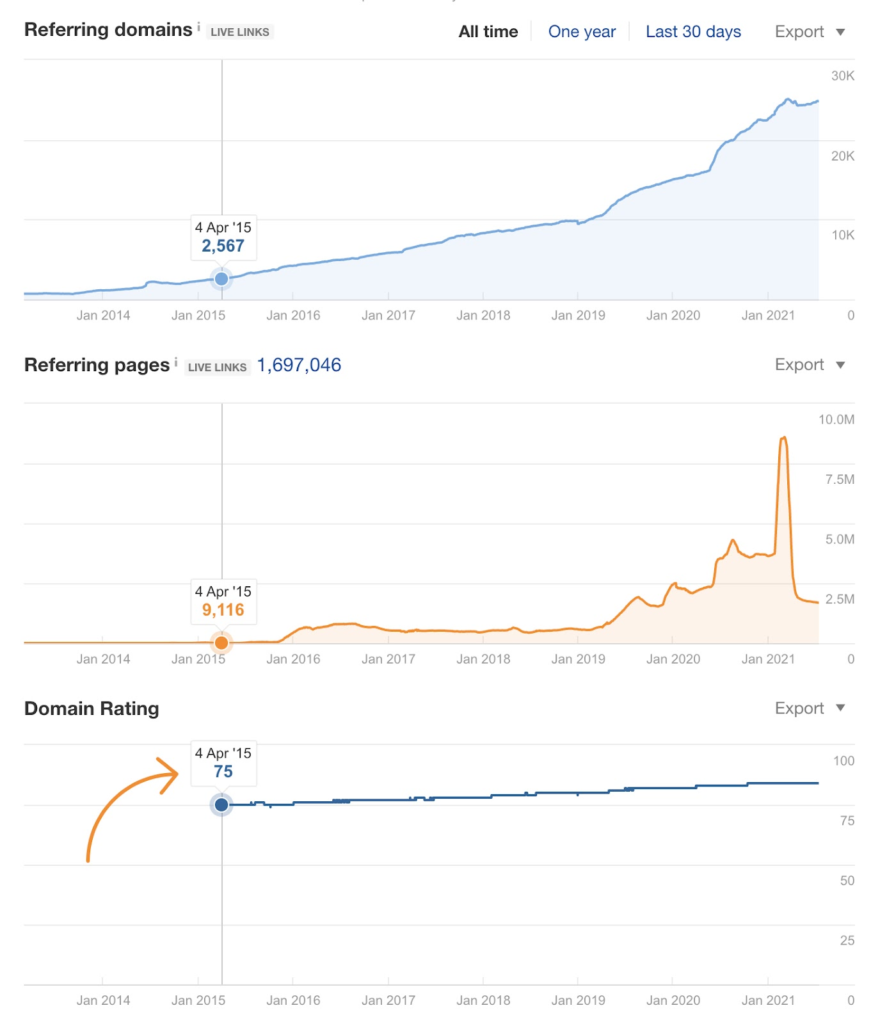
Creative communication campaign
When I did my research on how Wise became the company it is today, I came across several examples of very good communications campaigns with great coverage and lots of links.
Wise’s communication campaigns go from advocating the values they defend in a fairly standard way:

These media stunts brought them great backlinks very quickly:
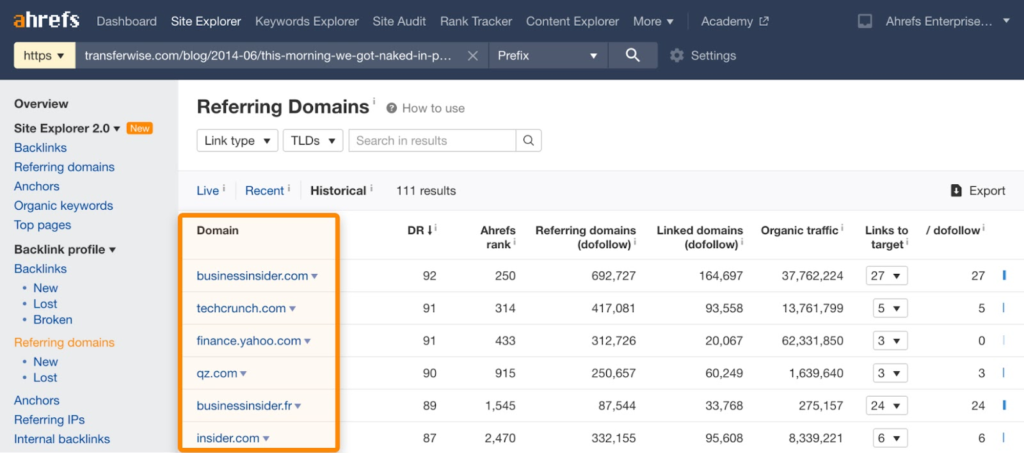
It is clear that communication and advertising helped them build a strong brand and a good link profile before they took SEO seriously:

Affiliate and referral programs as primary acquisition channels
Wise encourages its users to invite friends with a monetary bonus, which quickly becomes one of their main acquisition channels:
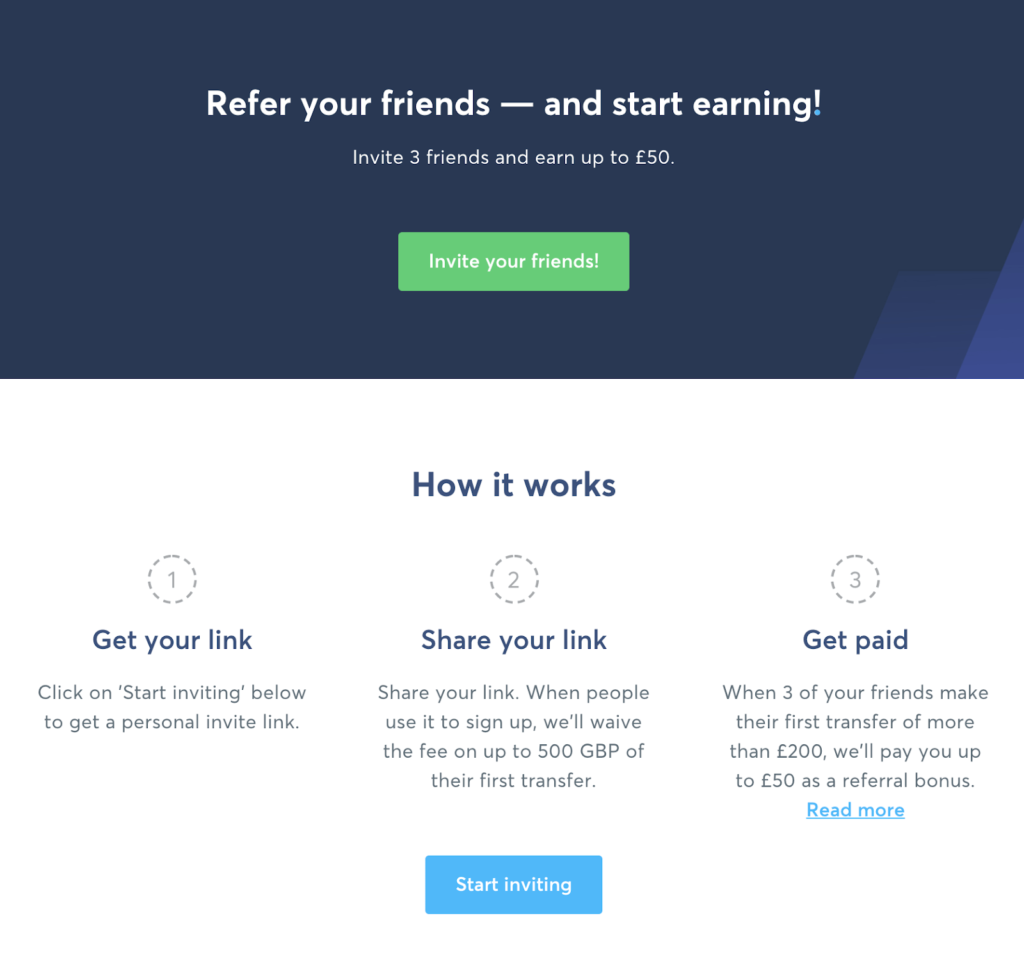
Wise also has an affiliate program that encourages site owners to earn commissions by sharing their affiliate links with their audience.
Of course, the SEO value of affiliate links is questionable at best. Wise currently has nearly 9,000 partner backlinks with no link attributes, which must pass PageRank:
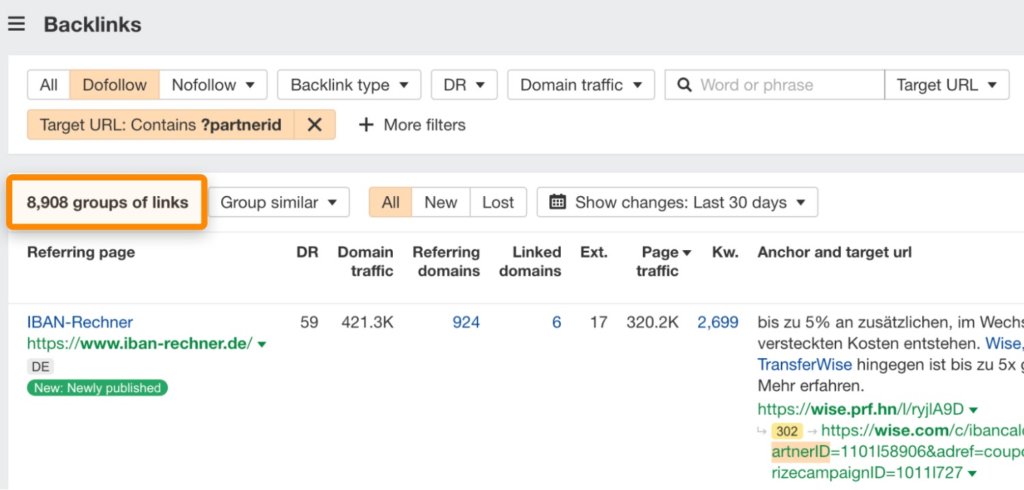
If we (Ahrefs) can easily identify such links, I’m sure Google can too. He must certainly devalue or completely disqualify these links in terms of PageRank.
But the goal here is different: the side effect of people sharing affiliate links is wider coverage and more standard links. The bigger your referral or affiliate program, the more profit you get from it. There is a snowball effect.
5- Migrating millions of error-free pages is very risky
Migrating a large site to a new domain is a potentially daunting task in itself. Add to that a large customer base who rely on your 24/7 services to manage their money. You get a challenge that would stress out any SEO professional.
Wise currently has just over 4 million URLs indexed by Google, and that number is sure to grow as they migrated from transferwise.com not too long ago (March 2021)
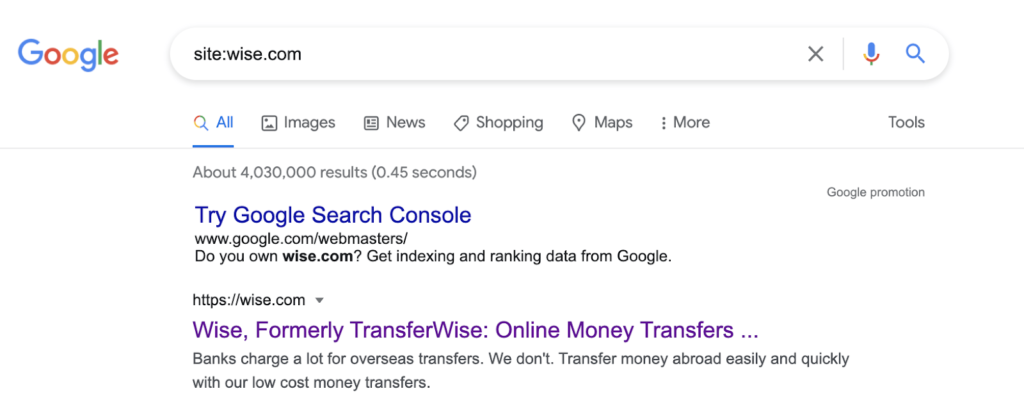
They managed to transfer their organic traffic without noticeable loss to their new domain in 4 months of migration. If you’re unfamiliar with site migrations, that’s a great result, a lot of migrations end up losing a big chunk of organic traffic.
Here is the organic traffic graph for transferwise.com
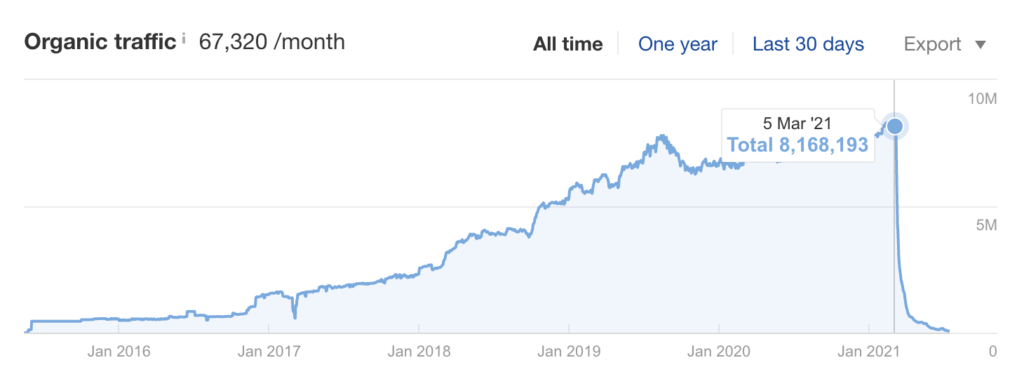
And here’s how it got transferred to wise.com
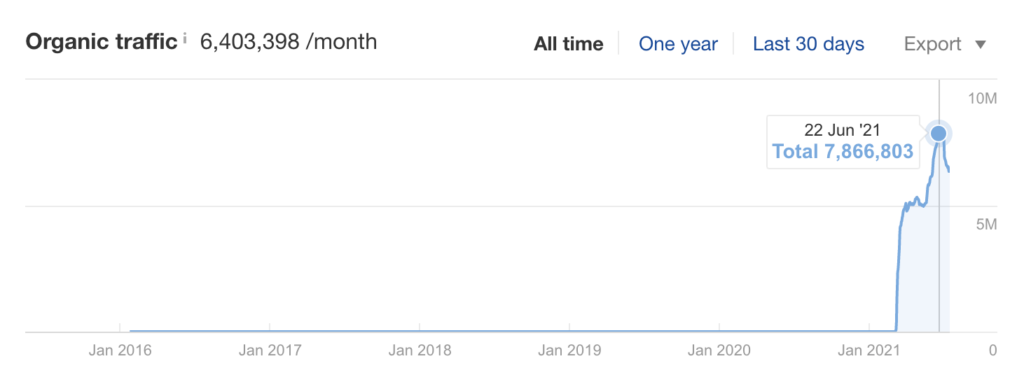
Migrating millions of pages, keeping the service active and stable during the procedure and not losing traffic with all this is a real success. But even when you seem to have done everything right, you can still run into issues that are hard to explain and fix:
Two pieces of advice seemed interesting to me to put forward:
- Properly inform your users and audience that a migration is coming soon. This was very important to Wise especially given the nature of their business. Suddenly arriving on a new domain for a blog is not comparable to logging in to monitor your bank accounts on a new domain without knowing it in advance.
- Test redirects on a small portion of your domain and follow server logs to understand how crawlers behave. This is indeed a good practice before doing a 301 redirect on your entire site.
Conclusion
Wise clearly stands out in their investment in SEO across all of their teams. This once again sheds light on soft skills in SEO. You need to properly communicate the value of SEO and your needs to other members of the organization to achieve this.
I found a few other elements that I could have exposed here, but these five were in my opinion the most interesting and inspiring. If you have any questions, ideas, or perhaps SEO analysis requests from other companies, feel free to comment it below.


